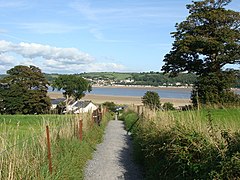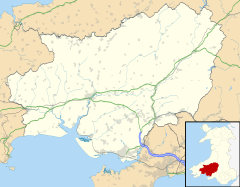Human settlement in Wales
Ferryside
| |
|---|---|
 Ferryside and the River Tywi from Llansteffan Ferryside and the River Tywi from Llansteffan | |
 | |
| Population | 846 |
| OS grid reference | SN366103 |
| Community | |
| Principal area | |
| Preserved county | |
| Country | Wales |
| Sovereign state | United Kingdom |
| Post town | Ferryside |
| Postcode district | SA17 |
| Police | Dyfed-Powys |
| Fire | Mid and West Wales |
| Ambulance | Welsh |
| UK Parliament | |
| Senedd Cymru – Welsh Parliament | |
| |
Ferryside (Welsh: Glan-y-fferi) is a village in the community of St Ishmael, Carmarthenshire, Wales. It is 8.5 miles (13.7 km) south of Carmarthen near the mouth of the River Tywi. Originally a ferry crossing, then becoming a fishing village, it has developed as a holiday and retirement area. The village has its own lifeboat station and was the first village in the UK to switch from analogue to digital television. The 2011 census showed the village to have 846 residents.
History
Originating as a landing-place on the ferry route to Llansteffan (the ferry was used by Giraldus Cambrensis in 1188), Ferryside developed as a fishing village. In 1844 the population of the parish was 895.
Much of the village developed after 1852, when it became linked to Carmarthen and Swansea by Isambard Kingdom Brunel's South Wales Railway.
Amenities
School
There is a school that has been there for over 150 years.
Worship

The parish church is St Ishmael's, built on a rock near the shore. In 2006, the graveyard and grounds were selected for an innovative project aimed at encouraging biodiversity in churchyards. There are two chapels near the centre of the village and another church, St Thomas, in the centre of the village.
Facilities
Ferryside has a post office, a public house (The White Lion), a sports and social club (previously the rugby club), a general store, hotel (Three Rivers Hotel & Spa), antiques shop and caravan park.
Transport
Ferryside railway station has regular rail connections to London Paddington, Pembroke Dock, Milford Haven, Carmarthen, Swansea and Cardiff. Bus services connect to Carmarthen and Llanelli.
Ferry crossing

The ferry service across the River Tywi to Llansteffan was discontinued in the 1950s.
A new service was launched in 2018 by Carmarthen Bay Ferries using a customized Sealegs Amphibious Craft offering 5-10 minute crossings to Llansteffan and 45 minute estuary and 1 hour sunset trips, having received a grant of £300,000 from the Coastal Communities Fund. The grant had been applied for by a former resident of the community, Professor Kenton Morgan and local reactions to the service and the culture of grantsmanship was covered in a BBC Radio 4 programme.
Community magazine
STISH is a monthly magazine by the St Ishmael's community for the villagers of Ferryside and Llansaint, run by volunteers to bring news of local events and articles of local interest. Ferryside Village Forum is an online source of information.
Sailing

Ferryside is home to the River Towy Yacht Club.
Lifeboat station
The Ferryside Lifeboat was first established in 1835, 11 years after Sir William Hillary founded a national lifeboat service which subsequently became the Royal National Lifeboat Institution (RNLI). Ferryside lifeboat was run by the RNLI until 1960, and was re-established as an independent service in 1966, one of more than 80 such stations around Britain and Ireland. It is now part of St John Cymru, the ambulance charity, and is launched by HM Coastguard in response to ’999′ calls and distress calls on VHF CH16. With the second largest tidal rise and fall in the world making the local waters hostile, the lifeboat is available 24 hours a day throughout the year. It is staffed by local volunteers who rely on donations to the service for its funding.
The current lifeboat station was constructed in 2010 and opened by the Duchess of Gloucester. The service uses a 6.4 metre Ribcraft semi rigid inflatable with twin 115 hp engines, and a smaller craft. Callouts average 28 a year, a number that is rising as a result of an increase in leisure craft. The station received a government grant to buy new equipment in 2017.
Fishing

Ferryside developed as a fishing village, particularly for shellfish.
Cockles
Along with Laugharne, Ferryside was once at the heart of the cockling industry in Carmarthen Bay. Cocklewomen from Llansaint could collect about 650 tons of cockles a year, and did so until around 1900. The cockle industry now experiences intermittent bursts of activity when the Ferryside cocklebeds are opened to commercial pickers: intensive 'strip-cockling' occurs and several hundred cockle-pickers work the estuary beds with tractors.
In 1993, Ferryside saw what are known locally as 'the cockle wars': fights between rival gangs on the beach, notably between gangs from the Gower Peninsula, Liverpool, the Dee estuary and Glasgow. Because commercial quantities of cockles at Ferryside were rare, there were no licences required to harvest them. In addition to gaining the village rare visibility on the front pages of national newspapers, the cockle wars led to a Parliamentary debate and calls for the beds to be licensed.
Analogue television switch off
Further information: Digital terrestrial television in the United Kingdom § Digital switchover, and Ferryside television relay stationOn 30 March 2005, Ferryside and Llansteffan became the first areas in the United Kingdom to lose their analogue television signals. Residents of the Carmarthenshire villages - on either side of the River Tywi - voted to switch to digital after taking part in a pilot scheme.
Homes were given digital receivers for each of their televisions. A helpline was set up for residents' teething problems, and one-to-one support was made available to the elderly.
After three months, the households were asked if they wanted to keep the digital services or revert to analogue only. More than 85% of households responded and 98% voted to retain the digital services. Hence at the end of March 2005, the analogue channels, BBC One Wales, ITV1 and S4C, radiating from the Ferryside transmitter, were switched off leaving BBC Two Wales as the only analogue channel remaining. Viewers wanted to keep this channel because it provided certain programmes that the digital equivalent, BBC 2W, did not show.
Notable people
Notable ex-residents of the village include the General Sir Thomas Picton of Iscoed Mansion, a former governor of Trinidad who died at the Battle of Waterloo, Hugh Williams, the 19th century Chartist lawyer who played a prominent role in the Rebecca Riots and the portrait and landscape painter Gordon Stuart (five of whose portraits can be found at the National Portrait Gallery, including those of Kingsley Amis, Dylan Thomas and Huw Wheldon). The parasitologist J. W. W. Stephens, FRS, was born in Ferryside in 1865. George Parry, a metallurgical engineer and prolific inventor of Ebbw Vale Steelworks retired to Ferryside in 1866 and died on 6 February 1873 at his residence Steel Villa.
Dylan Thomas was a regular visitor to Ferryside, both as a child and later when he lived in Laugharne. His maternal great-aunt, Amy, had married Captain David Jones, the Ferryside coxswain. They lived at Alpha House in Eva Terrace. Their son, David, ran the Dorothy Café next to the Ship Inn; he was followed there by his son, Raymond, who was Thomas’ second cousin. Thomas’ drinking in the White Lion, and his friendship with Dick Bright of 2, Neptune Villas, is described by Bright's niece, Beryl Hughes. Thomas' childhood holidays in Ferryside have been described by Stanford-ffoulkes, a descendant of Amy and David Jones. There is more on Dylan Thomas and Ferryside, with photos and a family tree, at Dylan and Ferryside
Ferryside may have been an influence in the writing of Under Milk Wood. Llareggub's occupational profile as a town of seafarers, fishermen, cockle gatherers and farmers has been examined through an analysis of the returns in the 1939 War Register for Ferryside, comparing the town to New Quay, Laugharne and Llansteffan. This analysis also draws upon census returns and the Welsh Merchant Mariners Index. It shows that New Quay and Ferryside provide by far the best fit with Llareggub's occupational profile.
References
- "Custom report - Nomis - Official Labour Market Statistics". www.nomisweb.co.uk. Retrieved 31 July 2021.
- ^ "GENUKI - St Ishmael". Retrieved 31 October 2014.
- "Ancient Carmarthenshire ferry crossing could be revived". BBC News. 9 March 2017. Retrieved 11 March 2017.
- "007-like ferry takes to water at Ferryside and Llansteffan". BBC News. 10 August 2018. Retrieved 14 August 2018.
- "Coastal Communities Fund, Wales - Round 4 Awards" (PDF). Lottery Fund. Retrieved 12 September 2019.
- "The Patch". BBC Radio 4. 10 September 2019. Retrieved 13 September 2019.
- "Ferryside Village Forum". Retrieved 4 November 2014.
- Fisher, Stuart (5 January 2012), Rivers of Britain: Estuaries, Tideways, Havens, Lochs, Firths and Kyles, Bloomsbury Publishing, p. 39, ISBN 978-1-4081-5931-6
- "Ferryside Lifeboat". Retrieved 4 November 2014.
- ^ "Ferryside Lifeboat - History". Retrieved 31 October 2014.
- "£70,000 cash boost for water rescue charities in Wales". BBC News. 12 November 2017. Retrieved 14 November 2017.
- "Ferryside". Discover Carmarthenshire. Retrieved 22 December 2024.
- ^ Prestage, Michael (22 June 1993). "Pickers muscle in on bumper cockle harvest: Michael Prestage on a shellfish bonanza in South Wales that has led to violence". The Independent. Retrieved 27 August 2012.
- "House of Commons Debates". Retrieved 5 November 2014.
- "Digital Switchover Trial Report, 2005" (PDF). Archived from the original (PDF) on 5 August 2011. Retrieved 3 November 2014.
- "National Portrait Gallery - Gordon Stuart". Retrieved 5 November 2014.
- Christophers SR (25 May 1946). "Obituary. J. W. W. Stephes, MD, FRS". Br Med J. 1: 816. doi:10.1136/bmj.1.4455.816. S2CID 220002567.
- "Graces Guide - George Parry".
- B. Hughes (1998) The Cat’s Whiskers, Hughes.
- R. Stanford-ffoulkes (2004) Dylan – the Cousin.
- Thomas, D.N. (2019) Llareggub and the 1939 War Register, published online at The 1939 War Register
External links
- Historical information on GENUKI
- Carmarthenshire County Council, Ferryside Walk
- Photographs of Ferryside and surrounding area Geograph
- Video footage of Ferryside Station
- Dylan Thomas, Llansteffan, Llandyfaelog and Ferryside